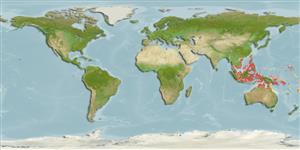>
Ovalentaria/misc (Various families in series Ovalentaria) >
Pseudochromidae (Dottybacks) > Pseudochrominae
Etymology: Pseudochromis: Greek, pseudes = false + Greek, chromis = a fish, perhaps a perch (Ref. 45335).
Eponymy: John Percy Moore (1869–1965) was an American zoologist who specialised in leeches. [...] (Ref. 128868), visit book page.
More on author: Fowler.
Environment: milieu / climate zone / rango de profundidad / distribution range
Ecología
marino asociado a arrecife; rango de profundidad 12 - 25 m (Ref. 90102). Tropical
Western Central Pacific.
Tamaño / Peso / Age
Madurez: Lm ? range ? - ? cm
Max length : 12.0 cm SL macho / no sexado; (Ref. 48635)
Espinas dorsales (total) : 3; Radios blandos dorsales (total) : 25 - 26; Espinas anales: 3; Radios blandos anales: 13 - 14. The Bali and Lombok population was recently described as a separate species as P. steenei on the bases of color differences. The white bar behind the eye, used to distinguish the species, fades in the Philippine and northern Australian populations, while in Sulawesi, it shows clearly. The ones with the orange head are thought to be male.
Body shape (shape guide): elongated; Cross section: compressed.
A very aggressive species that readily attacks the camera when it sees its own reflection. Mainly found on deep coastal slopes with remote sponges and crinoids in about 30 m depth and often occurs in pairs (Ref. 48635).
Life cycle and mating behavior
Madurez | Reproducción | Puesta | Huevos | Fecundidad | Larva
Gill, A.C., 1999. Pseudochromidae. Dottybacks (eelblennies). p. 2557-2577. In Carpenter, K. E. and V. E. Niem. 1999. Species identification guide for fisheries purposes. The living marine resources of the western central Pacific. Bony fishes part 2 (Mugilidae to Carangidae). FAO, Rome. : iii-v; 2069-2790. (Ref. 37748)
IUCN Red List Status (Ref. 130435: Version 2025-1)
Threat to humans
Harmless
Human uses
Herramientas
Special reports
Download XML
Fuentes de Internet
Estimates based on models
Preferred temperature (Referencia
123201): 27.5 - 29.4, mean 28.8 °C (based on 1019 cells).
Phylogenetic diversity index (Referencia
82804): PD
50 = 0.5000 [Uniqueness, from 0.5 = low to 2.0 = high].
Bayesian length-weight: a=0.00501 (0.00193 - 0.01299), b=3.10 (2.88 - 3.32), in cm total length, based on LWR estimates for this (Sub)family-body shape (Ref.
93245).
Nivel trófico (Referencia
69278): 3.7 ±0.5 se; based on size and trophs of closest relatives
Resiliencia (Referencia
120179): Alto, población duplicada en un tiempo mínimo inferior a 15 meses (Preliminary K or Fecundity.).
Fishing Vulnerability (Ref.
59153): Low vulnerability (10 of 100).
🛈
